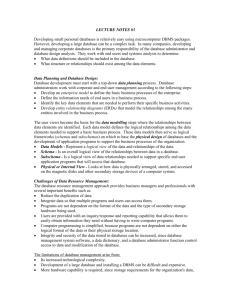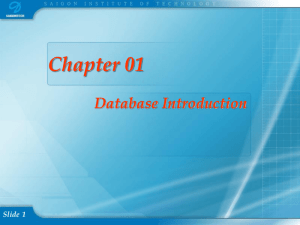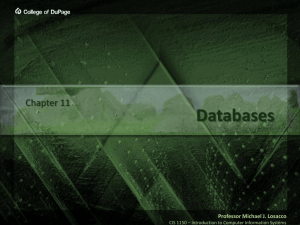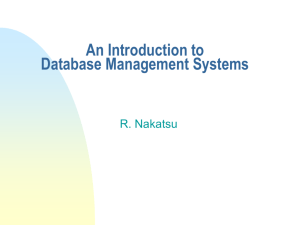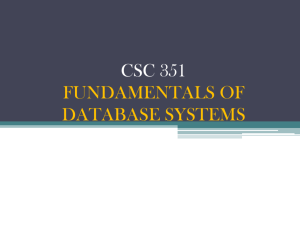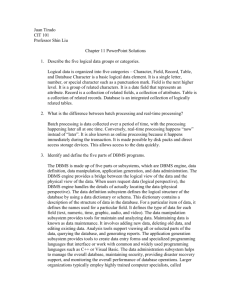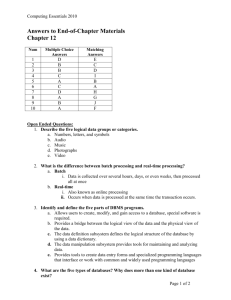File Systems and Databases - Department of Computer Science
advertisement
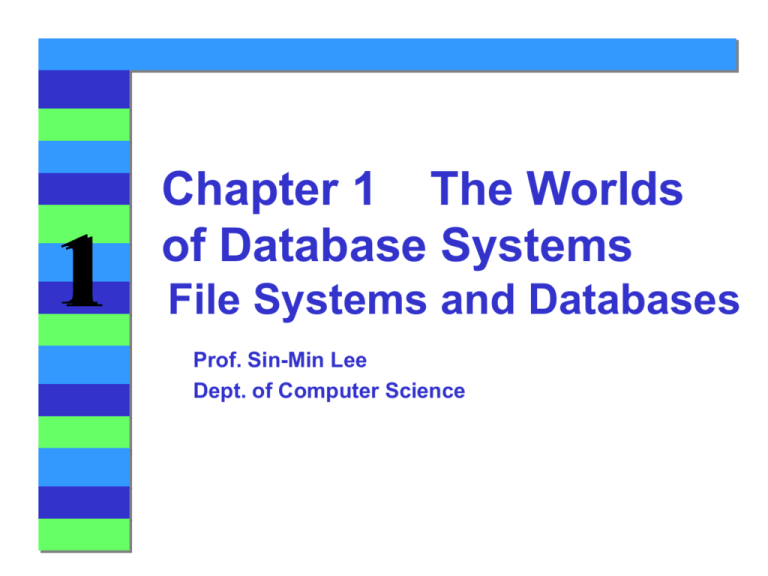
1 Chapter 1 The Worlds of Database Systems File Systems and Databases Prof. Sin-Min Lee Dept. of Computer Science 1 Tuesday Thursday 10:15 – 11:30 Your evaluation in this course is determined by: 30% 1 Class Presentation 10% Presentation report 5% ??! 1 1 Text 1 Book NARAYAN S. UMANATH & RICHARD W. SCAMELL, DATA MODELING AND DATABASE DESIGN, 2007 Thomson GOOD REFERENCE A. Silberschatz, H.F. Korth, S. Sudarshan: Database System Concepts, 5th Ed., McGraw-Hill, 2006. 1 1 The mediocre teacher tells. The good teacher explains. The superior teacher demonstrates. The great teacher inspires. Files and Databases 1 File: A collection of records or documents dealing with one organization, person, area or subject (Rowley) Manual (paper) files Computer files Database: A collection of similar records with relationships between the records (Rowley) Bibliographic, statistical, business data, images, etc. Introducing the Database Major Database Concepts 1 Data and information Data - Raw facts Information - Processed data Data management Database Metadata Database management system (DBMS) 1 1 Sales per Employee for Each of ROBCOR’S Two Divisions 1 Figure 1.1 1 Database Systems Types of Database Systems Number of Users 1 Single-user – Desktop database Multiuser – Workgroup database – Enterprise database Scope Desktop Workgroup Enterprise Database Systems Types of Database Systems 1 Location Centralized Distributed Use Transactional (Production) Decision support Data warehouse Database 1 A Database is a collection of stored operational data used by the application systems of some particular enterprise (C.J. Date) Paper “Databases” File-Based Data Processing Systems Still contain a large portion of the world’s knowledge Early batch processing of (primarily) business data Database Management Systems (DBMS) Why DBMS? History 1 50’s and 60’s all applications were custom built for particular needs File based Many similar/duplicative applications dealing with collections of business data Early DBMS were extensions of programming languages 1970 - E.F. Codd and the Relational Model 1979 - Ashton-Tate and first Microcomputer DBMS File Based Systems Application 1 Delivery List Coal Estimation Just what asked for File Toys Addresses Naughty Nice Toys From File Systems to DBMS Problems with file processing systems 1 Inconsistent data Inflexibility Limited data sharing Poor enforcement of standards Excessive program maintenance DBMS Benefits 1 Minimal data redundancy Consistency of data Integration of data Sharing of data Ease of application development Uniform security, privacy, and integrity controls Data accessibility and responsiveness Data independence Reduced program maintenance Terms and Concepts Data independence 1 Physical representation and location of data and the use of that data are separated The application doesn’t need to know how or where the database has stored the data, but just how to ask for it Moving a database from one DBMS to another should not have a material effect on application program Recoding, adding fields, etc. in the database should not affect applications Database Environment 1 CASE Tools Repository User Interface DBMS Application Programs Database Database Components DBMS =============== Design tools 1 Database Database contains: User’s Data Metadata Indexes Application Metadata Table Creation Form Creation Query Creation Report Creation Procedural language compiler (4GL) ============= Run time Form processor Query processor Report Writer Language Run time Application Programs User Interface Applications Types of Database Systems 1 PC databases Centralized database Client/server databases Distributed databases Database models PC Databases 1 E.g.: Access FoxPro Dbase Etc. Centralized Databases 1 Central Computer Client Server Databases Client 1 Client Network Database Server Client Distributed Databases Location C 1 Location B computer computer computer Location A Homogeneous Databases Distributed Databases Client Heterogeneous Or Federated Databases Database Server Remote Comp. 1 Local Network Comm Server Client Remote Comp. 1 1 1 Introducing the Database Importance of DBMS 1 It helps make data management more efficient and effective. Its query language allows quick answers to ad hoc queries. It provides end users better access to more and better-managed data. It promotes an integrated view of organization’s operations -- “big picture.” It reduces the probability of inconsistent data. 1 The DBMS Manages the Interaction Between the End User and the Database 1 Figure 1.2 1 Introducing the Database Why Database Design Is Important? 1 A well-designed database facilitates data management and becomes a valuable information generator. A poorly designed database is a breeding ground for uncontrolled data redundancies. A poorly designed database generates errors that lead to bad decisions. 1 1 1 1 Historical Roots Why Study File Systems? 1 It provides historical perspective. It teaches lessons to avoid pitfalls of data management. Its simple characteristics facilitate understanding of the design complexity of a database. It provides useful knowledge for converting a file system to a database system. Contents of the CUSTOMER File 1 Figure 1.3 1 1 Table 1.1 Basic File Terminology 1 Data “Raw” facts that have little meaning unless they have been organized in some logical manner. The smallest piece of data that can be “recognized” by the computer is a single character, such as the letter A, the number 5, or some symbol such as; ‘ ? > * +. A single character requires one byte of computer storage. Field A character or group of characters (alphabetic or numeric) that has a specific meaning. A field might define a telephone numbers, a birth date, a customer name, a year-to-date (YTD) sales value, and so on. Record A logically connected set of one or more fields that describes a person, place, or thing. For example, the fields that comprise a record for a customer named J. D. Rudd might consist of J. D. Rudd’s name, address, phone number, date of birth, credit limit, unpaid balance, and so on. File A collection of related records. For example, a file might contain data about ROBCOR Company’s vendors; or, a file might contain the records for the students currently enrolled at Gigantic University. Contents of the AGENT File 1 Figure 1.4 A Simple File System 1 Figure 1.5 1 1 1 1 1 1 1 1


